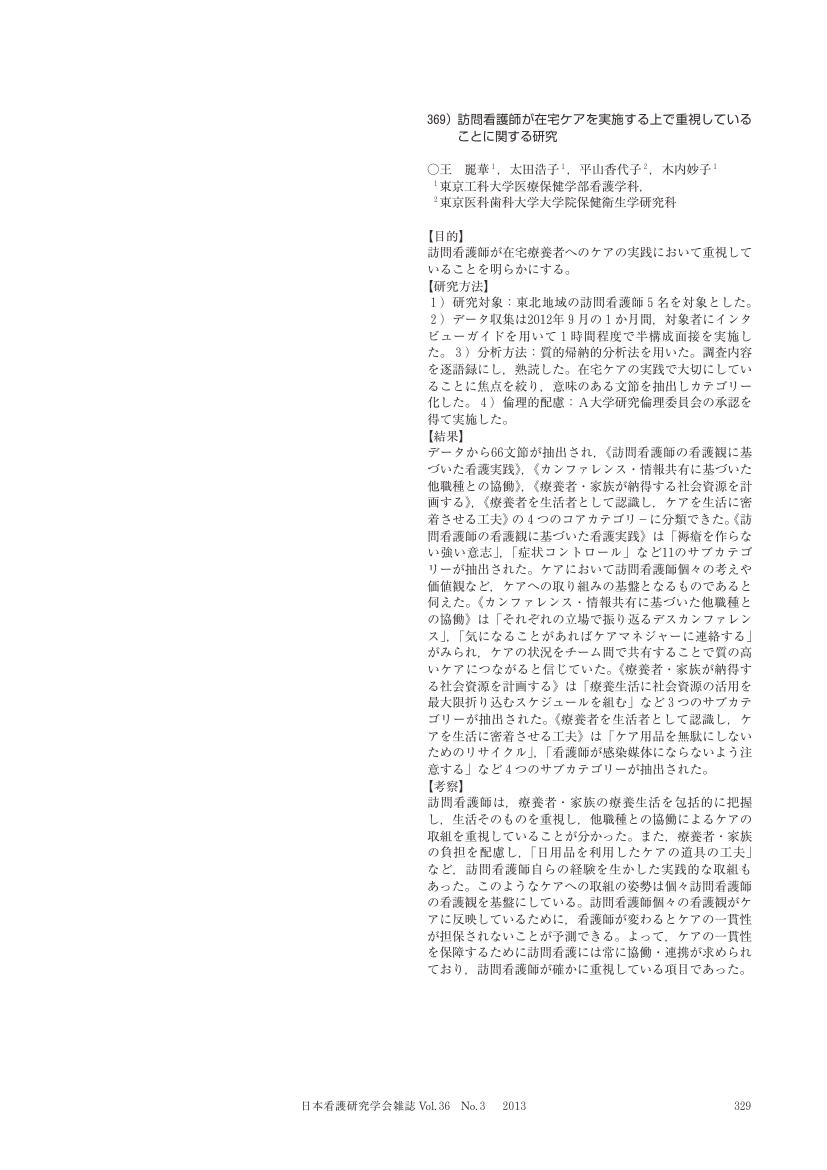2 0 0 0 OA エスノグラフィックリサーチの方法と研究事例
- 著者
- 法橋 尚宏 太田 浩子 林 綺婷 和辻 雄仁
- 出版者
- 一般社団法人 日本看護研究学会
- 雑誌
- 日本看護研究学会雑誌 (ISSN:21883599)
- 巻号頁・発行日
- pp.20220519160, (Released:2022-07-12)
- 参考文献数
- 32
エスノグラフィックリサーチは,“エスノグラフィックインタビューと参加観察を主とするフィールドワーク(現地調査)によって,イーミックとエティックな視点から対象の生活世界で起きている現象や文化を記述する方法論”である。これは方法のトライアンギュレーションであり,フォーマルインタビュー,インフォーマルインタビュー,参加観察,質問紙調査,既存の書籍・文献・ウェブサイト資料の収集,写真撮影,映像撮影などを行う。データ収集と分析を繰り返しながら,問いや仮説を精緻化する。信用可能性,確認可能性,脈絡に応じた意味,反復的パターン形成,飽和,転用可能性などを質的評価基準として,信憑性を保証する。すべてのデータは定性化してフィールドノーツに記述し,コーディングを行い,コードの類似性と相違性の観点からカテゴリー化した後,テーマにそってストーリー化して報告書にまとめる。
2 0 0 0 OA バーチャル体験による子育て学習
- 著者
- 太田 浩子 寺本 正恵 王 麗華 木内 妙子 松永 信介 稲葉 竹俊
- 出版者
- 教育システム情報学会
- 雑誌
- 教育システム情報学会誌 (ISSN:13414135)
- 巻号頁・発行日
- vol.31, no.1, pp.93-98, 2014-01-01 (Released:2014-02-26)
- 参考文献数
- 13
1 0 0 0 OA エスノグラフィックリサーチの方法と研究事例
- 著者
- 法橋 尚宏 太田 浩子 林 綺婷 和辻 雄仁
- 出版者
- 一般社団法人 日本看護研究学会
- 雑誌
- 日本看護研究学会雑誌 (ISSN:21883599)
- 巻号頁・発行日
- vol.45, no.2, pp.2_159-2_175, 2022-07-20 (Released:2022-07-20)
- 参考文献数
- 32
エスノグラフィックリサーチは,“エスノグラフィックインタビューと参加観察を主とするフィールドワーク(現地調査)によって,イーミックとエティックな視点から対象の生活世界で起きている現象や文化を記述する方法論”である。これは方法のトライアンギュレーションであり,フォーマルインタビュー,インフォーマルインタビュー,参加観察,質問紙調査,既存の書籍・文献・ウェブサイト資料の収集,写真撮影,映像撮影などを行う。データ収集と分析を繰り返しながら,問いや仮説を精緻化する。信用可能性,確認可能性,脈絡に応じた意味,反復的パターン形成,飽和,転用可能性などを質的評価基準として,信憑性を保証する。すべてのデータは定性化してフィールドノーツに記述し,コーディングを行い,コードの類似性と相違性の観点からカテゴリー化した後,テーマにそってストーリー化して報告書にまとめる。
1 0 0 0 OA 369)訪問看護師が在宅ケアを実施する上で重視していることに関する研究
- 著者
- 王 麗華 太田 浩子 平山 香代子 木内 妙子
- 出版者
- 一般社団法人 日本看護研究学会
- 雑誌
- 日本看護研究学会雑誌 (ISSN:21883599)
- 巻号頁・発行日
- vol.36, no.3, pp.3_329, 2013-07-22 (Released:2018-11-30)
1 0 0 0 OA 伝承と子どもを結ぶもの : 松谷みよ子『龍の子太郎』をめぐって
- 著者
- 太田 浩子
- 雑誌
- 東京女子大學附屬比較文化研究所紀要
- 巻号頁・発行日
- vol.47, pp.95-104, 1986
Tatsu no ko Taro [Taro the Dragon Boy] is an lengthy imaginative children's story written by MATSUTANI Miyoko. Into this story the author has woven legends on Koizumi Kotaro who controls water, transmitted in Shinshu [Nagano Prefecture], as well as a number of legends and folk tales of other parts of Japan. It is a representative work of postwar Japanese juvenile literature which has been continuously finding new readers among the Japanese children since its first publication in 1960. Taro, the hero of the story, is a spirited boy, born of a mother who had been transformed into a dragon. He wrestles with animals. He expels ogres who have been tormenting people. He cultivates the paddy field and harvests rice. Through these and other experiences, he grows and comes to entertain an aspiration that, by draining a lake, he can create a vast track of new arable land for people of poor mountain villages. With the help of his dragon mother, he manages to realize this dream by demolishing mountains to let the water of the lake escape into the sea. A central thread of this story of growth is the hero's tenderness. Folk tales and legends which are transmitted orally tend to become fragmentary, and their characters are often stereotyped. MATSUTANI Miyoko, the author, came across the legends of Koizumi Kotaro in Shinshu during her journey to search and record folk tales. On the basis of them but with a hope to "make the Taro [i.e. Kotaro] of Shinshu into a Taro of entire Japan, " she lavished her imaginative power on the creation of the hero, Taro, the dragon boy with a great success. The plot and the growth of the hero are closely knit in this story, and the cheerful optimistic hero is given a unique credible personality. Aiming at creating a new literary work which is at the same time anchored firmly in tradition, the author has managed to create in this story an attractive hero who strikes a responsive chord in the hearts of all children. She also has taken great pains to devise a suitable "narrative" style in order to
1 0 0 0 OA 伝承と子どもを結ぶもの : 松谷みよ子『龍の子太郎』をめぐって
- 著者
- 太田 浩子
- 出版者
- 東京女子大学
- 雑誌
- 東京女子大學附屬比較文化研究所紀要 (ISSN:05638186)
- 巻号頁・発行日
- vol.47, pp.95-104, 1986
Tatsu no ko Taro [Taro the Dragon Boy] is an lengthy imaginative children's story written by MATSUTANI Miyoko. Into this story the author has woven legends on Koizumi Kotaro who controls water, transmitted in Shinshu [Nagano Prefecture], as well as a number of legends and folk tales of other parts of Japan. It is a representative work of postwar Japanese juvenile literature which has been continuously finding new readers among the Japanese children since its first publication in 1960. Taro, the hero of the story, is a spirited boy, born of a mother who had been transformed into a dragon. He wrestles with animals. He expels ogres who have been tormenting people. He cultivates the paddy field and harvests rice. Through these and other experiences, he grows and comes to entertain an aspiration that, by draining a lake, he can create a vast track of new arable land for people of poor mountain villages. With the help of his dragon mother, he manages to realize this dream by demolishing mountains to let the water of the lake escape into the sea. A central thread of this story of growth is the hero's tenderness. Folk tales and legends which are transmitted orally tend to become fragmentary, and their characters are often stereotyped. MATSUTANI Miyoko, the author, came across the legends of Koizumi Kotaro in Shinshu during her journey to search and record folk tales. On the basis of them but with a hope to "make the Taro [i.e. Kotaro] of Shinshu into a Taro of entire Japan, " she lavished her imaginative power on the creation of the hero, Taro, the dragon boy with a great success. The plot and the growth of the hero are closely knit in this story, and the cheerful optimistic hero is given a unique credible personality. Aiming at creating a new literary work which is at the same time anchored firmly in tradition, the author has managed to create in this story an attractive hero who strikes a responsive chord in the hearts of all children. She also has taken great pains to devise a suitable "narrative" style in order toallow children to have an easy access to the world of folk tales through it. In this essay, through the examination of the author's intention, the characterization of the hero, and the style, I have tried to demonstrate that Tatsu no ko Taro really succeeds in building a bridge between the world of folk tales and the children of today, which, in my opinion, is one of the important roles Japanese juvenile literature can play.


